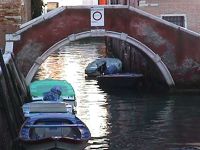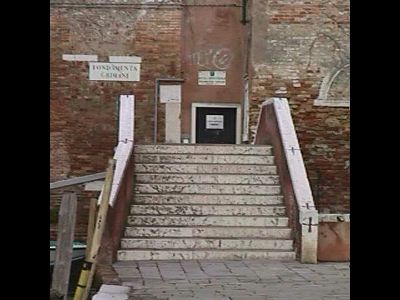Ponte Moro
 | |
| Basic Information | |
| Bridge Code | |
| Zucchetta Number | |
| Canal Crossed | |
| Handicapped Accessible? | |
| Length (m) | |
| Width (m) | |
| Minimum Height (m) | |
| Latitude (°) | |
| Longitude (°) | |
| Private | |
| Crooked Bridge? | |
Overview of Bridge
The Ponte Moro was built primarily using Mattoni e Pietra d'Istria. It crosses the Rio Grimani bridging a gap which is 5.95 meters. The bridge is not a crooked bridge. On the northern side of the bridge is the sestiere of Cannaregio and on the southern side is also Cannaregio .There are 2 ramps. On the north side there are 9 steps, on the south side there are 11 steps. This results in a total of 20 steps. The height of a typical step is 17 meters, the thickness of a step is about 37 centimeters, and the width of a step is about 2.56 meters.The steps are paved with Trachite. The bridge is not handicapped accessible and it does not have an additional railing. The summit is 2.6 meters wide and 2.35 meters in length for a total area of about 6.11 meters. The summit is paved with Trachite. Also, this bridge has 1 arch. The bridge's Piena railing is made of Mattoni, Intonaco e Pietra d'Istria and is about 24.00 meters wide is about 0.86 meters tall. Finally, the bridge protrudes 0.5 meters to the North and 0.15 meters to the South.

History
The following is any history we have regarding the bridge's origins:
�to S. Jerome. Rammemora Sansovino in his \Venetia\ a building which, in the guise of big castle, built in S. Senator Jerome Leonardo Moro, and praises the adjoining garden. This building, which, as can be seen in a plan of Venice of 1572 was equipped with four towers, there is still Moro neck coat of arms carved on the walls repeatedly. The family, who owned it, to other streets of the city called themselves, came to Padua in the early days, and made up in 1280 in an illustrious Marino, very rich man, who defeated the rebels Triestini, and founded the hospitable Mercy. As for the Doge Cristoforo Moro, which took place under various patrii events, he is best known for his piety and for the friendship of S. Bernardino of Siena, who for his firmness and courage for his military. It tells the Sanudo that, not wanting to take part in the crusade this doge banned by Pope Pius II, Victor Hat, naval captain, in pien Senate said, \Most Serene Prince, if your not the serenity Vora leave the co bone, we'll go for strength because gavemo highest first well-el and the honor of being tera, that no person x and yours. \ Narrasi well that comforted the Moro Condur him with the promise of four directors, added: \I VORIA co sier Lorenzo Moro, that x Duke de Candia, asmiragio of a galley, because I no I mean de armade\ to which the Senate agreed with the words: \If you will like ela dise.\ The crusade, however, for the Pope's death, which occurred August 15, 1464, broke up, and the weak doge, well pleased in his heart, he could return to Venice glue fleet. He died in 1471, and was buried in the chapel of S. Job, and at that monastery, made from it manufacture, tied, having no sons, and all his substance. The Moro family also produced some of the bishops, and some brave generals, among them John, who in 1509 was sent to the defense of the coast of Apulia, in 1510, joined with canals in the Po, brought the Milanese high terror; punch in 1528 in Puglia joined with the French, taking many cities in 1537 was finally superintendent in Candia, where he died in 1539, hit by a stone on the head, while he was rushed to quell a fierce battle has arisen between soldiers and islanders.
Location
The bridge is located at the following coordinates:
Latitude: 45.4439642° N
Longitude: 12.3320923° E